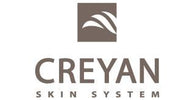Article by Elisabeth Bergvall (owner of the products of the Cosmeceutical Creyan Skin System) in Cosmetics International 09/2022:

According to studies, discolouration on the face even makes us look older than wrinkles and contributes to a troubled complexion. If you want to lighten them, you need a lot of patience and perseverance - and the appropriate active ingredients. An overview.
Dark spots are usually caused by sunlight, but they can also occur post-inflammatory and as a result of hormonal changes. New pigment spots or spots that change shape, structure and color and itch or bleed should definitely be examined by a dermatologist. In addition to the recommendation to protect the skin daily and permanently with a sun protection factor, there are active ingredients with a tyrosinase inhibitor effect . They inhibit the formation of melanin, prevent overproduction and in some cases prevent future hyperpigmentation. "Tyronisase inhibitors" do not produce an immediate bleaching effect. It takes time to see a visible effect on the newly formed cells. The faster immediate effect is achieved by laser treatment. Chemical peels and microdermabrasion work alongside the whitening agents by removing the already pigmented cells from the skin's surface. This leads to faster, more visible results than using active ingredients alone.
With a gentle effect
Niacinamide is a water-soluble form of vitamin B3 with diverse properties. It can strengthen the skin barrier, regulate sebum production, reduce wrinkles and alleviate redness and inflammation. It also has a lightening effect on pigment spots and can reduce them. The active ingredient has light-protecting properties and can be combined with a sun protection product to prevent pigment spots. Its regenerative properties also help prevent post-inflammatory hyperpigmentation (PIH) as it reduces inflammation that could lead to skin discoloration. Niacinamide reduces pigmentation by inhibiting melanin transfer to skin cells and combines very well with tyrosinase-inhibiting active ingredients. Long-term use for the best possible effect is possible thanks to its good tolerability.
Duo for an even complexion
N-Acetyl Glucosamine (NAG) or just acetyl glucosamine is a sugar building block and one of two components of hyaluronic acid. NAG occurs naturally in the human body and, thanks to its small molecule size, has a very good ability to penetrate the skin. This allows for deeper effectiveness in the skin. NAG's abilities are versatile, there are several independent studies that support its effectiveness.
Even in low concentrations (from 2%), the NAG achieves visible results against hyperpigmentation, especially in combination with niacinamide. The super duo niacinamide and NAG work together particularly effectively against pigment shifts and ensure a more even complexion. NAG suppresses melanin production (tyrosinase inhibitors), niacinamide helps to prevent melanin from being transported to the surface and spread. The combination is suitable for all skin types and can be used permanently. In addition to the ability to bind water deep in the skin layers, NAG promotes the formation of hyaluronic acid in the skin. It refines the complexion by loosening dead skin cells and also protects against free radicals.
Licorice root (Glycyrrhiza glabra root extract) is multi-talented and very popular in cosmetics because it contains so many components with beneficial properties. The extract has powerful anti-inflammatory, soothing, antioxidant and brightening effects. The ingredient is very often used as a natural “whitener” in cosmetics. Licorice root extract contains both melanin-inhibiting substances (glabridin) and melanin-degrading substances that reduce existing superficial pigment spots.
With a stronger effect
Vitamin C (ascorbic acid) inhibits the formation (tyrosinase inhibitor) of melanin and can be used in higher concentrations (when stably formulated) to lighten pigments that have already formed. However, the high concentration required to have a keratolytic effect has the potential for irritation.
However, the vitamin C derivative Ascorbyl Phosphate can inhibit and lighten even in low concentrations without irritating.
Azealic acid (dicarboxylic acid) only works effectively on pigment spots in high doses and then requires a prescription. At lower concentrations, it may have an effect on pigment spots when applied to the skin for a long period of time.
Alpha Arbutin is a biosynthetic active ingredient with a melanin-inhibiting effect and at the same time an antioxidant. In contrast to other lightening agents, Alpha Arbutin is not a tyrosinase inhibitor, but hinders the melanin-forming activity of the tyrosinase enzyme. Alpha Arbutin is well tolerated, can be used at low concentrations (2%) daily to lighten UV-induced, inflammatory and environmental pigmentation. Alpha arbutin is naturally contained in mulberry extract, for example.
Resorcinol (resorcinol) is a chemical agent and one of the strongest tyrosinase inhibitors. It regulates melanin production, reduces and corrects sun-induced pigment spots, inflammatory hyperpigmentation and melasma.
Kojic acid (metabolic product of Aspergillus species) inhibits tyrosinase and can effectively bleach unwanted pigmentation. The new formation of pigment spots is prevented and in combination with niacinamide it is particularly effective. Kojic acid is very common in Asia.
Hydroquinone (a phenol derivative) is the most effective tyrosinase inhibitor and contributes to the destruction of melanocytes. It is not approved for over-the-counter sale in Europe, but can be prescribed by dermatologists in particularly stubborn cases. A clear brightening can be observed during application. Has a high potential for irritation.
Supporting ingredients
Retinol (Vitamin A) supports the lightening process by stimulating skin renewal and helping to shed pigmented skin cells faster. It also regulates tyrosinase activity so that this enzyme produces less melanin.
Antioxidants have a preventive effect by being able to slow down harmful oxidative processes in the skin and thus prevent pigment spots from developing. In general, antioxidants have a cell-regenerating effect and have an impact on existing pigment spots.
Anti- inflammatory agents can prevent post-inflammatory hyperpigmentation.
Click to download article:
Elisabeth Bergvall: The experienced beauty expert and consultant in the field of medical cosmetics is the owner and managing director of Nordesta. The Munich-based company develops and markets products from the Creyan Skin System cosmeceuticals.
Cosmetics International 09/2022





